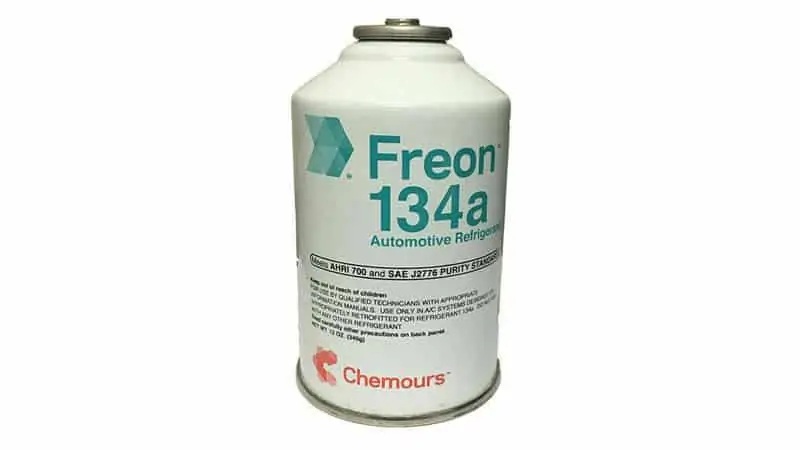Freon can leak slowly from your car’s air conditioning system over time. The system is highly pressurized and even careful driving can still be rough on your vehicle, causing leaks. If too much refrigerant such as Freon leaks, can you add freon to your car by yourself?
Freon can be added via certain products purchasable at most auto parts stores or online. The process should only take 15 minutes and is relatively inexpensive. You don’t need specialized tools or to be a mechanic to complete the process.
I’ll point out the ways to check your coolant levels as well as understand why you need to top up your Freon from time to time. However, I’ll also take you through the signs that you’ll need a professional to fix these issues and the common things to be aware of.
What Are The Steps To Add Freon To My Air Conditioner?

First, you’ll need to check for leaks. Then, check the refrigerant pressure with a pressure tester. Finally, you can charge your air conditioner with more refrigerant.
It is important to remember that you shouldn’t try to do this if you have a hybrid or electric car and should instead visit a mechanic to have this process carried out.
Checking for leaks is an important part of this process. Your air conditioner shouldn’t be leaking large amounts of refrigerant so that it requires constant top-ups or refills. If it does, you likely have a large underlying issue that needs to be fixed by an expert.
Small leaks can be found with dyes or just by using a spray bottle with soapy water in it. Spraying the soapy water on the pipes and joins of the system while it is running will result in bubbles forming around the leak.
Next is checking the refrigerant or Freon pressure. You’ll need to purchase a refrigerant recharge hose kit or refrigerant charging kit. One good option is the R134a AC Refrigerant Recharge Hose Kit with Measuring Pressure Gauge you can find on Amazon.com.
Refrigerant is a dangerous substance and so you should ensure you have proper protection. This means goggles, gloves, and covering up your skin as much as possible, such as wearing long sleeves. Frostbite can result if the substance comes into contact with your skin.
There will be a hose in the refrigerant recharge kit that attaches to the low-pressure line port.
The low-pressure line generally has larger gauge tubing than the high-pressure line, making it easy to distinguish between the two. Look for the “L” labeling for low. Unscrew the cap and attach the hose.
Take a reading using the pressure gauge and it should be around 40 psi or in the safe or green zone on the display. If it isn’t this is a sign you have to refill the refrigerant and check again using the pressure gauge.
To refill the refrigerant, purchase refrigerant as recommended by your manufacturer or that is compatible with your vehicle. Sometimes this is listed under the hood of the vehicle.
Next, you will need to unscrew the refrigerant trigger from the can to remove the inner cap. The trigger may have some sort of valve on top and a metal pin on the inside.
The inner cap is disposable and stops the refrigerant trigger from piercing the can. Screwing the trigger back on without the cap will pierce the can and you will hear the sound of pressure being released.
Agitate the refrigerant to mix its contents. This can prevent clogging and allow the refrigerant to flow through the system smoothly.
From here you will need to attach the Freon can to the low-pressure port that you took a pressure reading at previously. Squeeze the trigger or turn the valve to start pumping refrigerant into the system.
Depending on how low your coolant is will determine how long you hold the trigger for. Most top-ups only require about 10 seconds of charge. It is better to be conservative and then just add more refrigerant later. Overcharging can damage the system.
Check once again with the pressure gauge to see whether it is in the green or safe zone. Excess Freon in your recharge kit can be kept for later. Make sure the trigger or valve is not open so that the refrigerant does not leak out over time.
Attach the low-pressure port cover back on and use a temperature gauge to test if the air conditioning is working to the desired temperature. You should expect the cool air to be between 0 to 10 degrees on full power.
The biggest hint that your system is working is if cool air is blowing when you’ve done the charge. You can also have the engine and air conditioner running and then check under the hood. A spinning compressor clutch is a great sign everything is good.
How Does Freon Make The Air Conditioning Work?

Air conditioning works by using a refrigerant known as Freon and a pressurized pump system. Refrigerant runs through the evaporator to cool air which is then blown inside the cabin. The coolness is produced by the condenser which squeezes the gas.
This squeezing process initiates a phase change, removing heat from the air.
Coolant can leak through holes or loose seals with the most common place at joints of the connection hoses. You may not be able to detect leaks by smell or sight as it is an odorless gas when it leaks. There also won’t be obvious evidence such as a puddle of water under the car.
Road projectiles smashing into the unit or damage to the car may compromise the system. The air conditioning depends on a functioning electrical system that is affected by blown fuses, wire damage, or a power surge.

